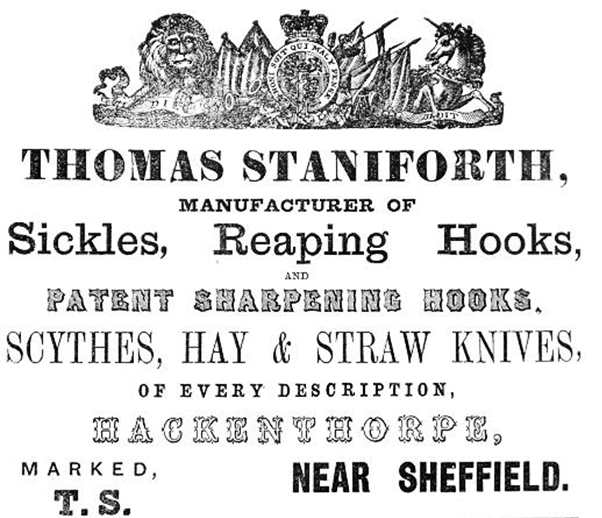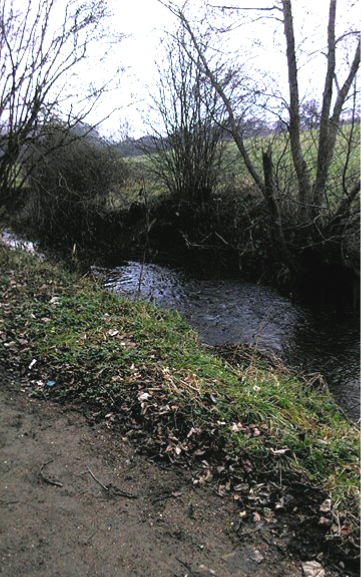
Thomas Staniforth & Co. Sickle works at Hackenthorpe.
 When looking into the origins of the Staniforth surname, I have heard several theories from people across the United Kingdom, but the most likely explanation, completely with documentation comes from the late historian David Hey. According to his publications, the surname of Staniforth has ancient origins and can be traced back to Ecclesfield parish, specifically in the area near Wincobank. Of course the surname is derived from ‘Stoney Ford’ which gives the impression of a river crossing, this likely refers to the Blackburn Brook that flows through Wincobank before meeting the River Don.
When looking into the origins of the Staniforth surname, I have heard several theories from people across the United Kingdom, but the most likely explanation, completely with documentation comes from the late historian David Hey. According to his publications, the surname of Staniforth has ancient origins and can be traced back to Ecclesfield parish, specifically in the area near Wincobank. Of course the surname is derived from ‘Stoney Ford’ which gives the impression of a river crossing, this likely refers to the Blackburn Brook that flows through Wincobank before meeting the River Don.
Based on local surnames from the 14th Century, it seems likely the area was originally named Stonyford, and that there was multiple farms and homesteads.
We can also find evidence on the 15th Century court rolls which show a John de Stannyford passing down land in ‘Stanyford’ to his son Richard. This is important as it not only proves the existence of such a place, but it also ties the surname variation Stannyford to the same land, which of course became Staniforth in later years. There are other variations from around this time, including Stanyford, Stannyforth and Stannyforthe, amongst others.
We can also find evidence of these early surname variations in Frances Margery Hext’s 1863 book ‘Staniforthiana’ which begins with a Thomas de Stonyford who was living during the Reign of Richard II in the 1380s. This same Thomas was also living during the reign of Henry IV in 1403.
Going back further, on Ecclesfield Poll tax records from 1379, there are two couples listed, Johannes de Staynford with his wife Isabella, and Henricus de Staynford with his wife Agnes. Henry’s occupation is recorded as being ‘souter’ or shoemaker. Thomas Stanyforth is also recorded in Handsworth in 1379. There is also a Robert de Staynford who’s will is proved May 31st 1391 in the North Yorkshire village of Giggleswick, however with the nearby hamlet of Stainford it seems likely he is unrelated.
One of the earliest known mentions of the surname is a Matild de Staniforthe mentioned on 1297 Subsidy Rolls from Ecclesfield.
It is also said that Staynford was known as ‘Hasler’ land which is land that is held by a person or subject that provided defense for the lord of the manor. They would have been armed with a spear during those times. Some names recorded as owning Hasler land in those times are Peter Stannyford, he held a messuage and a single bovate of hasler land in 1410. William Stannyford also held half an acre in 1413, and John de Stannyford passed down two bovates to his son and heir Richard de Stannyford in 1434. There is also a Henry connected to this land, who surrenders it in 1500. Henry Staneforth, likely the same, is recorded as a witness to a land purchase by John Greaves of Wyndill in Ecclesfield in 1523.
T Walter Hall compiled the early Sheffield Court Rolls in a publication titled Sheffield Manorial Records 1424 to 1624, and on page 39 we find the following: “At a small court held of Gilbert Earl of Shrewsbury at Sheffield on the 6th July 1591” it mentions “a fourth part of a messuage and an oxgang of hastler land in Wincobanck and Stanyford in the soke of Sowthey...” The description further describes “a fourth part of the aforesaid messuage and lands in Wincobank and Stanyford, as then long ago divided, to wit, of and in a capital messuage with all houses and buildings standing under the same roof and of and in a structure of 2 bays in the lower end of the orchard there called the Sheepcote , ...”. This might show connections to the area being close to what is now Shepcote Lane in Tinsley. This area is again slightly north of the spot where the Blackburn Brook flows into the River Don, further pointing to this general area, close to the original ‘Meadow Hall’ being the location of the surnames origins. This is further proven in the early Darnall families that show baptisms with residences recorded as being in ‘Meadow hall, Tinsley’.
Another source that gives information on these earlier Staniforths is a will that was proved 21st July 1586:
‘Richard Stanyforth of Wincobank in the parish of Ecclesfield, yeoman, will dated 10 July 1585 - my goods to be divided into three parts - one part to Agnes Stanyforth my wife - one to my children Richard, Nicholas and Alexander my sons and Elizabeth Jane Maud and Ann my daughters, and the remaining part to myself, - To the poor of Ecclesfield - to William Parkin "my beat gowe" = Richard Stanyforth my nephew - my sons Nicholas & Alexander my executors - William Wilkinson & Thomas Bullins supervisors’
By 1881, there were 1133 Staniforths in Great Britain, by 1997 there were 1917, and by 2011, 1963 Staniforths existed.
It is interesting to note that this land seems to have retained its name into the 17th Century, as a line of Parkyn men pass down land, starting on the 3rd June 1539, John Parkyn surrenders, in his will, 1 messuage and 2 acres in ‘Stainford near Wincobank’ to his son John Parkyn, his son appears to be deceased and so Nicholas Parkyn seeks the same land. In 1540-1 John Parkyn, son of Nicholas Parkyn deceased seeks the same land however he is underage so his mother Margaret is appointed his guardian. On the 28th of April 1603 Nicholas Parkyn of Thorpe, cutler, son of John Parkyn late of Southey, Cutler, Deceased and Agnes wife of the said Nicholas Parkyn and John Parkyn of Southey, cutler, son and heir of the said John Parkyn deceased surrender 1 messuage and 2 acres in Staynford near Wincobank to Edward Parkyn, third son of John Parkyn of Southey deceased. In a later surrender a fourth son, Francis Parkyn is mentioned as well as daughter Helen.
It is, of course hard to determine where exactly the homesteads once stood, especially with the construction of modern roads and housing, however it is likely with all of the flat land surrounding the Blackburn brook itself that many of the homesteads stood close by. It is also very likely that the present Meadowhall Shopping Centre stands very close to the site of the original Staniforth home.